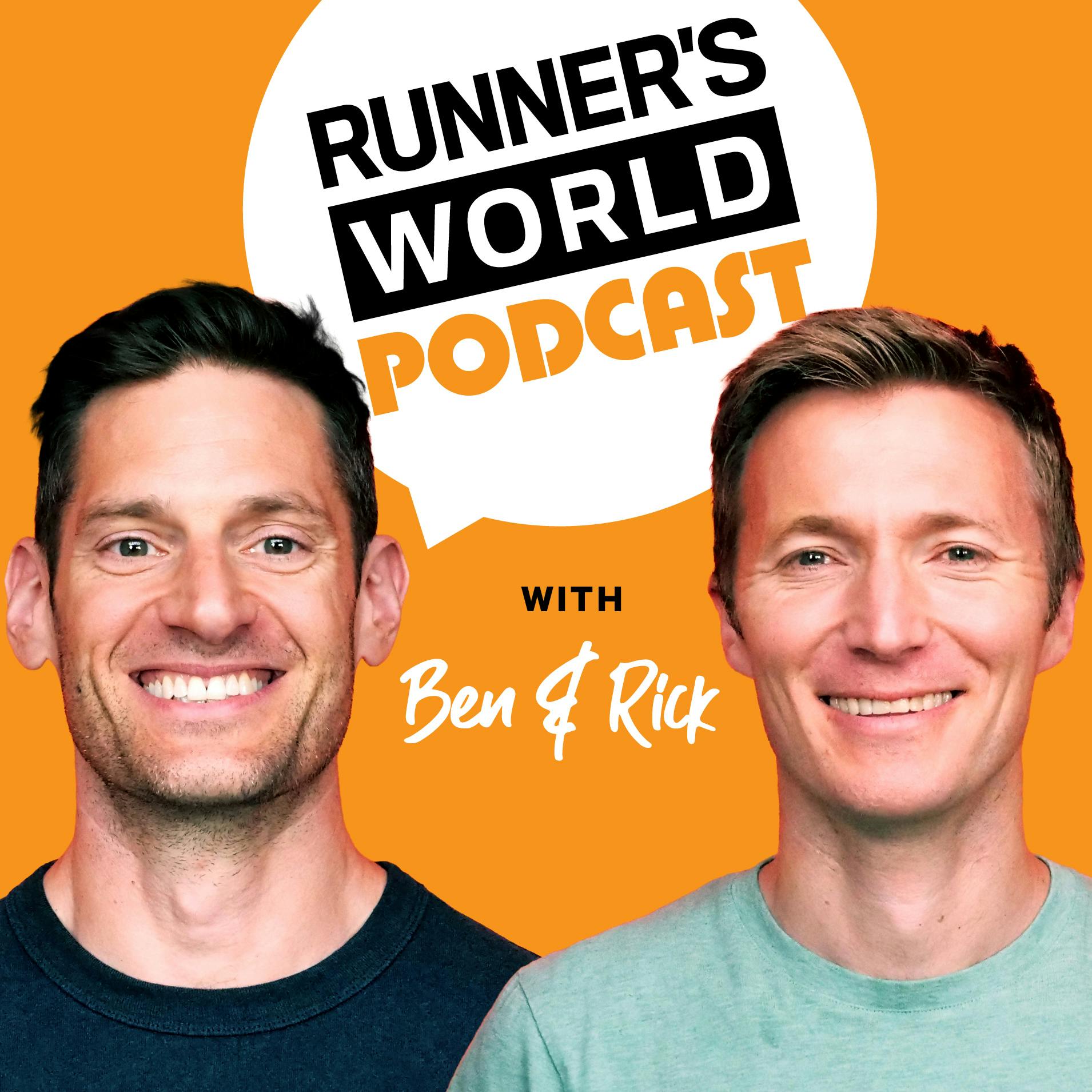
Brian's Run Pod
Welcome to Brian's Run Pod, the podcast where we lace up our running shoes and explore the exhilarating world of running. Whether you're a seasoned marathoner, a casual jogger, or just thinking about taking your first stride, this podcast is your ultimate companion on your running journey.
Join us as we dive deep into the sport of running, covering everything from training tips and race strategies to personal stories and inspiring interviews with runners from all walks of life. Whether you're looking to improve your race times, stay motivated, or simply enjoy the therapeutic rhythm of running, Brian's Run Pod has something for every runner.
Brian's Run Pod
Breathe Better, Run Faster
Dr. Amy Novotny, a physical therapist turned breathing and pain specialist, shares her revolutionary approach to running performance and pain management through proper breathing mechanics. After discovering that changing her breathing technique eliminated her running pain and improved her marathon times by 14 minutes, she developed the Pain Awareness Breathing Relief method to help other runners transform their performance.
• Physical therapist with impressive running credentials: 40 marathons, 10 ultras including two 100-milers, and an Ironman
• Common misconception: diaphragmatic breathing is NOT belly breathing
• Pushing your belly out when inhaling actually engages back muscles and triggers fight-or-flight response
• Proper technique: allow belly to "spill out" when exhaling, not suck in
• Correct breathing is our natural state as children, but stress changes our patterns over time
• Pain often attributed to aging is actually from accumulated stress-altered breathing
• Learning proper mechanics takes approximately six weeks of consistent practice
• Proper breathing shifts the body from stress-dominant state to balanced, relaxed state even during exercise
• Technique helps engage correct muscles (hamstrings, inner thighs) while deactivating overworked ones
Dr Amy Novotny's website
Brian's Run Pod has become interactive with the audience. If you look at the top of the Episode description tap on "Send us a Text Message". You can tell me what you think of the episode or alternatively what you would like covered. If your lucky I might even read them out on the podcast.
Instagram
So you're thinking about running but not sure how to take the first step. My name is Brian Patterson and I'm here to help. Welcome to Brian's Rompod. Well, hello there, everyone, and welcome back to another episode of Brian's Rompah.
Speaker 1:Today we're going to be talking about something that is very natural to us. It is something we do every day without thinking, and you might be asking what has this to do with running? Well, today I'm hanging out with Dr Aby Novotny is that correct, I think, and from the PABR Institute, and Aby is a running legend. She's done 40 marathons, 10 ultras, yep, including two 100 milers. An Ironman and a physical therapist turned breathing and pain specialist. We'll dig into how her pain awareness breathing relief method helps runners shake off chronic pain, stay injury free and even run faster by calming the nervous system. Owen will definitely hear some of her personal running stories as well.
Speaker 1:So, without further ado, let's welcome Amy to the podcast. Yeah, we've got an audience here somewhere. Thank you, brian. Anyway, welcome Amy to coming onto the podcast, to Brian's Romport. I know I didn't include this in the outline, but first of all I just wanted to go back to kind of your I usually ask this into high school, were you quite you know, were you an academic or were you more sort of a sporting person? I know you're a doctor, but obviously you must have been, you know, into science anyway. So what's your story there?
Speaker 2:Yeah, I was very academic, like extremely nose in the books. I still did sports. I did tennis for a while and I was a very good tennis player, but my whole purpose was get as many scholarships as possible so I didn't have to pay for school or college, yeah going to university so I was extremely academic, took all the college prep courses that were available and went that route.
Speaker 1:Yeah, is the uh medical profession in your family. I mean, do you are your parents doctors, or is it just you?
Speaker 2:no, oh my, I don't. I think my dad may have gotten a high school degree, maybe. Yeah, my mom barely did. And then when I was in high school, I tutored her while she got her bachelor's and master's. So I helped her for six years, oh wow, while I was in high school too, because she wasn't able to handle the pace of college. So I would tutor her until about midnight and then I would study from midnight to four in the morning. Sometimes I'd go all-nighters and then did it that way. So it was a rough six years, but I was very proud of her that she got her degree. But I was the first one to get a doctorate in in your family or family.
Speaker 1:Okay, oh, brilliant, that's excellent. So, um, moving on to uh, to to running, and you kind of your story and how you got into sort of um the is, would I is that. Am I allowed to shorten it to pabra, or do you just call it pabra Cabaret?
Speaker 2:yeah, yeah, cabaret yeah.
Speaker 1:So you were a runner, but you did have a few issues while you were running. Is that right?
Speaker 2:Yes. So after I finished my doctorate, then I started to become a physical therapist.
Speaker 1:Right.
Speaker 2:And as a physical therapist I had a little bit of free time in the morning because my shift didn't start until later, so I decided to just start running. I had never run before, so I just started running and I kind of got into it. And after about a year or two is when I started noticing oh, I have the typical little aches and fiends that other runners have some things that other runners have.
Speaker 2:I did the typical physical therapy rehab recommendations stretch foam, roll, strengthen, balance training, agility training, all those and you know, they still kind of came on and off and I had run several marathons by then.
Speaker 2:And then I was introduced to a new thought process on rehab and recovery, and this was at least three or four years into my career as a physical therapist and that type of thinking got me to reflect while I was running on how to change my breathing mechanics, not breath work but, changing my mechanics of how I breathe while I was in the middle of a treadmill run, and so I was running eight miles in an hour, or in about 55 minutes, and as I was running, I realized, if I changed my breathing mechanics a certain way, yeah, all of a sudden any of the aches and pains that I typically had these went away.
Speaker 2:And then when I got off the treadmill, if I kept that up, when I got off the treadmill I didn't have to stretch, foam roll, scrape, all these things that I was doing just to maintain. It's like huh. So I started asking around and asked other runners and physical therapists it's like huh. So I started asking around and asked other runners and physical therapists if you've experienced this, you know, has anyone ever tried this? And no one knew what I was talking about, right? So I kept up with it and with no changes in my training. I did this for three months and the next marathon I ran, I dropped seven minutes off my time.
Speaker 1:Wow.
Speaker 2:I was like wow, and the marathon was easy, like it. You know marathons are hard. It's like you live a lifetime in the course of a 26.2 mile race.
Speaker 1:Yeah.
Speaker 2:But felt easy, like there wasn't the ups and downs I want to kill myself, I love life. There wasn't the whole emotional rollercoaster, it just felt like, huh, okay, I can do this. So I kept up with it Again, no other changes in my strengthening agility training, running training. And again, a few months later, I ran a very hilly race the St George Marathon, extremely hilly and I dropped another seven minutes off my time. It's a net downhill but there's a lot of very steep uphills in it and I was flying high. And so I got down to a 319 marathon and, you know, blew through the Boston qualifying times, and so at that point I was already thinking, okay, I need to put this into a process and start teaching people.
Speaker 2:So I had to get volunteers from my physical therapy patient load to see who would try this, who would be a guinea pig, to let me experiment on them yeah and that that's kind of how I started dabbling into it and creating this process, and it was several, several years later that I actually created the power institute in the business.
Speaker 1:Right, okay, I mean there are a couple of things there, because I know I don't know if it's something that I mean you don't have to be running marathons but I know something that I struggle with in terms of even running on a treadmill.
Speaker 1:I don't know what it is, but I find it sometimes it can be a struggle to do 20-25 minutes on a treadmill, whereas if I'm outside it's a different kettle of fish. I mean, you know, I even do the same. For instance, um, yesterday I was in the gym and it was raining here and so I thought, well, I don't go on the treadmill, and but, um, whereas on the weekend I I ran outside same session and I'm you know if accounting for gps and all that kind of thing but I'm doing less in terms of the distance than I am compared to outside and I'm running faster outside. So I'm thinking, well, is it something to do with you psychological thing, or, like you said, is it something that is a breathing thing, that when I'm on the treadmill I'm feeling completely out of breath and I'm sweating profusely? That kind of thing? Do you think that can have a factor?
Speaker 2:well, the treadmill requires a little bit more work on your mind and the mental part of it, if you don't like try switch. Yeah, most people don't really like them.
Speaker 2:They're wonderful if you're in alaska or somewhere cold to run outside, um, but they require a lot of mental training. And also your stride changes just a little bit on the treadmill, because most people feel a little bit more compressed when they're on the treadmill and the belt, of course, is running and moving forward. So how your muscles work there's a slight change in all that. So there is a little bit more stress with running on the treadmill versus outside, especially if you love the outdoors. So that slight stress plus the mental load of being on a treadmill will change your breathing mechanics a little bit. It's not a grand amount but it will adjust you a little bit. It shouldn't make that much of a difference. The type of breathing mechanics changes that I'm talking about make a much, much bigger difference. But it's more of a mental thing. When you look at treadmill versus running outside because of the different scenery, you're distracted, distracted, all of those things so where do we?
Speaker 1:I mean so, so, so, what in particular was it that changed the way you you were breathing? I mean, what, what was what was that? That starting point sure.
Speaker 2:So a lot of people and I was taught this too. In my physical therapy training. We were taught diaphragmatic breathing is belly breathing. Yeah, wrong, wrong, completely, absolutely wrong. Diaphragmatic breathing is not belly breathing. If you breathe in and push your belly out, you're distending your abdomen. That's not using your diaphragm Right. So when you push your belly out as you breathe in, you're actually helping contract your back muscles, which will actually put you in a fight or flight breathing state. The more your back muscles along your spine are contracted, the more you're going to be in a heightened alert state. So what we want to do is actually support the diaphragm and get the diaphragm to do the work without all the accessory muscles in our trunk and torso doing the work. And the biggest thing is when you exhale, you want your belly to spill out, not suck in. Most people do the exact opposite. Most people, when they blow out, they think, okay, suck your gut in to try to push the air out.
Speaker 1:Yeah.
Speaker 2:When you blow out, you want your belly to spill out, so your rib cage can drop down.
Speaker 1:Right.
Speaker 2:Eventually and not right away, but eventually. Your side abs help pull the ribs down yeah, then they provide a supporting surface, support walls, for the diaphragm to drop down effectively on the inhale, so you don't use your neck, shoulders, backs, intercostals to do the work that the diaphragm is designed to do. Most people don't do that. They either push their belly out when they inhale or they lift their ribs up when they inhale. Both are very effective and put your body in a fight or flight state, which means the muscles are going to tighten up. You're going to use muscles that you shouldn't be using and you'll start to get muscles that pull your bones and joints out of position, get aches and pains. It's simple as that, but also as hard and complicated as that, because breathing is so fundamental to our existence and most don't like to change the way they breathe. And they also think why do I need to change the way I breathe? I oxygen and I'm alive. Yeah, breathing is much more than that and it really does cause pain or not cause pain so so.
Speaker 1:So basically, you're kind of trying to change what they're doing on on a natural basis and does it take sort of like several goes at it. You know it's something that you can't do over time, it's something that you kind of have to practice over time yeah, I work with people for weeks.
Speaker 2:Yeah, so at minimum, I work with people for six weeks. It takes time to learn this and you, you made a really good point there. What people are breathing now, or how they are breathing now, is actually what they've developed as a teenager or adult. They were a kid and a toddler. They breathe the way that I'm talking about.
Speaker 1:Ah, yes, yes.
Speaker 2:Somehow. So what I'm trying to do is get them back to the natural way of breathing instead of the way they've developed. And I say this I have a toddler right now and I've watched him since birth. I've taken videos, I've taken photos and I've watched him from birth and I'm like, yep, he breathes exactly the way I'm right now teaching adults how to change their breathing mechanics, the way I'm right now teaching adults how to change their breathing mechanics.
Speaker 2:But sometimes, somewhere in our life, we've had some type of trauma, some type of emotional stress, some type of overstress in our life where, as soon as you feel a stressor, your breathing mechanics change period. It's a human, natural response, and the problem is is we forget how we used to breathe before that stressor, or we have too many stressors added up on top of each other that we can't convert back, and so then our breathing mechanics just subtly change over time and so we get to the state that we're in, and a lot of times people attribute pain to growing older. It's not because you're getting older. It's because the stress levels have added up so much. They've changed your breathing mechanics, which has caused muscles to contract more than they should, or other ones to deactivate and not work, and it's truly a matter of that.
Speaker 1:yeah, because I know sometimes I get this kind of shortness of breath every. I don't know why it is and it's truly a matter of that. Yeah, Because I know sometimes I get this kind of shortness of breath I don't know why it is and it's like as if I'm breathing from here, from the mid-level chest, and then suddenly it's usually if I'm sitting down, you know, or you know like lying in bed or something like that, and it's like you're, you know, I'm trying to. It's not an asthma thing. I don't suffer from asthma, but it is. I can see you nodding and you can understand. Yeah, yeah.
Speaker 2:Your rib cage is just too high.
Speaker 1:Yeah.
Speaker 2:So, and I can even see in the little video, your shoulders are high, your rib cage is too high.
Speaker 1:Okay, yeah.
Speaker 2:So if you your rib cage is held too high all the time and then you have any type of stressor or and it can be something you're just thinking about stressor, yeah all of a sudden you can't.
Speaker 2:You're used to lifting your ribs to breathe. There's a point where you physically can't lift your ribs anymore. You're going to be short of breath. So the more, the faster and with practice that you learn to drop your ribs down, the shortness of breath goes away all right, because something, and after a while, then suddenly it sort of goes away.
Speaker 1:Is it down?
Speaker 2:yep it just down and you don't like. You don't get short of breath because now you're using your diaphragm to breathe yeah shortness of breath is a sign that you're not using your diaphragm to breathe. Yeah, it's a sign that you're using your ribcage to breathe. So let me give you an example.
Speaker 2:So if you think in your mind of like a sprinter, when you think of a sprinter, you know they have their ribcage lifted up, their back is arched, they're running on the front of their feet, their forefoot and they're running as fast as they can. So they are purposely putting themselves in a fight or flight mode, as they should, because they're sprinting. Sprinting is you want to go as fast as possible, so you want every part of your body to be in a fight or flight mode to help you go as fast as possible. That's fabulous, and if you look at them, their rib cage is lifted up, especially at the very end when they're pushing hard.
Speaker 2:Now, if they want to go fast but go a little bit longer, they're going to have to pull their rib cage down a little bit so that way they last where their legs go faster and go a little bit longer. If you want to go longer, you have to get your rib cage down more and more. So you have to pull yourself out of that fight or flight state and your breathing mechanics out of a fight or flight state so that you can go longer at a faster pace. So we don't want to exist in that fight or flight state, in that breathing fight or flight state, for most of our waking and sleeping hours Only for short periods of time. Do you actually want to be in that state like a sprinter for a short, very short distance?
Speaker 1:I don't know if we're able to do an exercise here. I'm trying to get there. So, basically, what should I be needing to do? So, if I'm breathing out, not breathing out, or do I start from breathing in and then, in order for me to be breathing out, so neither.
Speaker 2:Right you actually want to start with how you're positioned. Yeah, so if you're just learning this, nothing really matters if you're in that position. So if I were in high heels right now and sitting on a bar stool, my pelvis would be tipped forward, my ribs would be lifted up. That would not be a good place for me to start, because my body is in a position of fight or flight Right. So any work that I do on my breathing at that point I'm just going to reinforce that I'm in a fight or flight state and the breathing will be the same way. So let's say we're sitting right here, so you're sitting, I'm sitting, your listeners, hopefully, are sitting.
Speaker 1:Yeah.
Speaker 2:You want to sit all the way back in your chair. Take away any lumbar support extra pillow that you have, if you can, if you don't have any pain, and you want to let your low back relax into the back of the chair and even tuck your tailbone under a little bit. So if you're used to sitting on the edge of the chair, you're going to feel very slouchy, like a slob.
Speaker 2:yeah, we want that yeah then you need to have your feet flat on a on the ground or on top of some books and you're. The height of your knees needs to be at, or above, the height of the crease in the front of your hips for most people, unless you're six foot four taller. Yeah, or I can't convert to centimeters that quickly um, no, no, we work in feet and itchings.
Speaker 1:So well, I'm, I think, in centimeters. Yeah, I'm 186, so I think, yeah, okay, so most people.
Speaker 2:Chairs are typically too tall for them and most of the time their knees are lower lower than that front crease in the hips, and you want your knees level or higher. So for most people, you need to have something under your feet. What that does? It gets you in a position of relaxation to make the change in your breathing mechanics much, much easier. Because when you're changing something as fundamental as breathing, you don't want it to be hard, you don't want other things to be in the way. Yeah, Okay.
Speaker 2:So let's say we're in that position now. So when we breathe and we're just going to go very simple for right now you can't change your inhalation until you've done a lot of work on the exhalation. So we're just going to say breathe in however you want to, but the only thing I say is breathe in through your nose. So you're going to breathe in through your nose and just observe. Can you feel your rib cage lift up? Can you feel your head lift up? Or shoulders? Do you feel your belly poof out? Do you feel your back contract? You're just observing and I can see you're lifting up.
Speaker 1:Yeah, yeah, that's right.
Speaker 2:You lifted your chest up. Your head went back. I can see that's happening.
Speaker 1:Yeah.
Speaker 2:Which I already knew that was going to happen, because your rib cage is up.
Speaker 1:Yeah.
Speaker 2:So you're lifting your rib cage to get air in.
Speaker 1:That's right, yeah.
Speaker 2:So your diaphragm is not as effective as it can be, and I'm saying this because it's something you can work on and it's someone should point it out so that you know what to work on. Yeah, so then, so you breathe in through the nose, you pause for a second, then you're going to blow out through your mouth and typically I tell people, if you don't have a straw like I have a straw and I use a straw all the time yeah, and blow out through a straw. Just make your lips in the shape of an o and you can put your pinky finger between your lips pull the finger out, then you know you have an O shape.
Speaker 2:You don't purse your lips together. That creates pressure. You don't want to huff air out. You want to blow air out like you're blowing through a straw to create a cylinder of air. And when you do that, if you have a hand on your belly of air, and when you do that, if you have a hand on your belly, you can start to feel your belly spill out and your chest go in as you blow out.
Speaker 2:Most people are used to doing the opposite, so it takes some practice. So then you breathe in through your nose. You just observe what's happening. Pause a second Now blow out through your mouth and feel your chest drop in under your hand, feel your belly spill out and your rib cage will start to drop down. Then you close your mouth, hold your breath for two to three seconds and then you breathe in through your nose Try and just observe, because we can't change your inhalation just yet and then you blow out. You blow out, your chest should melt in, your ribs should drop down, your belly should spill out and as you practice that, you'll start to feel your rib cage drop down.
Speaker 1:Yeah.
Speaker 2:Start to feel when your rib cage drops down. Your shoulders can drop down so your neck can elongate. Your back starts to relax more in the chair, you start to feel your thighs relax and maybe even your hip flexors. The hip flexors are harder to get off yeah but you can relax.
Speaker 2:So what you're working on is how to get your exhalation to be a parasympathetic experience for you, so your body relaxes. So we're trying to get stress, tension out of your muscles by changing your exhalation Eventually, and this takes time. When you've learned how to do that, then you can change the way you inhale so it is also relaxing and you use your diaphragm. Then your breathing is no longer going to tighten you up and then it fully relaxes you. So then when you're running and let's say you're running and yeah, you're starting out of breath, you know, okay, I need to work on my breathing mechanics so that my inhalation and exhalation calms me down and you can feel muscles in your body release right, and or you feel the muscles start to release.
Speaker 2:You start working on what muscles should be active, because a lot of times we we get used to using muscles that keep us in a fight-or-flight state. We want those ones to relax and the ones that have been on vacation for a while, we want them to start to activate. So almost the muscles that support the parasympathetic nervous system, like hamstrings, inner thighs, triceps, shoulder blade muscles we want to kick those in so the other ones stay off so you can run 26, 50 miles pain-free in the mountains, up and down, stepping over tree branches, and do it pain-free and fast and not have issues. That's how you do it.
Speaker 1:But obviously you need to make or be doing this over a number of weeks or whatever, so it becomes second nature. And then you can start. It takes time.
Speaker 2:It takes time. Yeah, it takes time, and for the most part, you need someone to watch.
Speaker 2:You do this because of course yes you don't, our ability to sense where our body is in space. It changes over time, yeah, and we often don't even know, and I I have to look in the mirror and watch myself because I I don't pay attention. And so you have to retrain that. And so, over time, you learn how to do it sitting, lying down on your hands and knees, standing, holding onto something, standing, not holding onto something. Breathing while walking. Breathing while moving. Breathing while running, because ultimately, as you're running in a race or out for fun, if you develop front of the knee pain, we know your hip flexors and quads became overdominant.
Speaker 2:Your ribcage has lifted up, your breathing mechanics have adjusted. You are now in a fight or flight mode and your back's overworking. So we have to get the ribca cage back down, your belly button to let go, your hip flexors to turn off your hamstrings, to turn on your inner thighs, to turn on your side abs, to turn on quads, to turn off ankle, to loosen up. And as you learn this process, you can do all that and the pain goes away within a couple minutes.
Speaker 1:Wow.
Speaker 2:And back to pain-free running.
Speaker 1:Who'd have thought that breathing could help your running times? Dr Novotny has shown through her own experimentation that she's developed a technique to alleviate soreness and pain. In our next episode we'll delve into this subject a little bit more and we'll talk about how I could improve using the technique. So thanks for listening, and don't forget to listen to part two of this fascinating subject.
Podcasts we love
Check out these other fine podcasts recommended by us, not an algorithm.

Life Changing
BBC Radio 4
Tech Life
BBC World Service
Runner's World Podcast
Runner's World UK
Buzzcast
Buzzsprout
Newscast
BBC News
Understand
BBC Radio 4
Cyber Hack
BBC World Service
Ghost Story
Wondery | Pineapple Street StudiosDiz Runs Radio: Running, Life, & Everything In Between
Join Denny Krahe, AKA Diz, as he talks with a variety of runners about running, life, and everything in between.
Uncharted with Hannah Fry
BBC Radio 4
The Global Story
BBC World Service
The Coming Storm
BBC Radio 4
Lives Less Ordinary
BBC World Service
Do Epic Shit Today Podcast
Hannah Mulhern
The Rest Is History
Goalhanger
